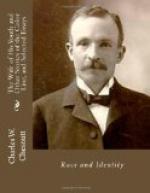Dick Owens had attended the trial. He was a youth of about twenty-two, intelligent, handsome, and amiable, but extremely indolent, in a graceful and gentlemanly way; or, as old Judge Fenderson put it more than once, he was lazy as the Devil,—a mere figure of speech, of course, and not one that did justice to the Enemy of Mankind. When asked why he never did anything serious, Dick would good-naturedly reply, with a well-modulated drawl, that he did n’t have to. His father was rich; there was but one other child, an unmarried daughter, who because of poor health would probably never marry, and Dick was therefore heir presumptive to a large estate. Wealth or social position he did not need to seek, for he was born to both. Charity Lomax had shamed him into studying law, but notwithstanding an hour or so a day spent at old Judge Fenderson’s office, he did not make remarkable headway in his legal studies.
“What Dick needs,” said the judge, who was fond of tropes, as became a scholar, and of horses, as was befitting a Kentuckian, “is the whip of necessity, or the spur of ambition. If he had either, he would soon need the snaffle to hold him back.”
But all Dick required, in fact, to prompt him to the most remarkable thing he accomplished before he was twenty-five, was a mere suggestion from Charity Lomax. The story was never really known to but two persons until after the war, when it came out because it was a good story and there was no particular reason for its concealment.
Young Owens had attended the trial of this slave-stealer, or martyr,—either or both,—and, when it was over, had gone to call on Charity Lomax, and, while they sat on the veranda after sundown, had told her all about the trial. He was a good talker, as his career in later years disclosed, and described the proceedings very graphically.
“I confess,” he admitted, “that while my principles were against the prisoner, my sympathies were on his side. It appeared that he was of good family, and that he had an old father and mother, respectable people, dependent upon him for support and comfort in their declining years. He had been led into the matter by pity for a negro whose master ought to have been run out of the county long ago for abusing his slaves. If it had been merely a question of old Sam Briggs’s negro, nobody would have cared anything about it. But father and the rest of them stood on the principle of the thing, and told the judge so, and the fellow was sentenced to three years in the penitentiary.”
Miss Lomax had listened with lively interest.
“I ’ve always hated old Sam Briggs,” she said emphatically, “ever since the time he broke a negro’s leg with a piece of cordwood. When I hear of a cruel deed it makes the Quaker blood that came from my grandmother assert itself. Personally I wish that all Sam Briggs’s negroes would run away. As for the young man, I regard him as a hero. He dared something for humanity. I could love a man who would take such chances for the sake of others.”




